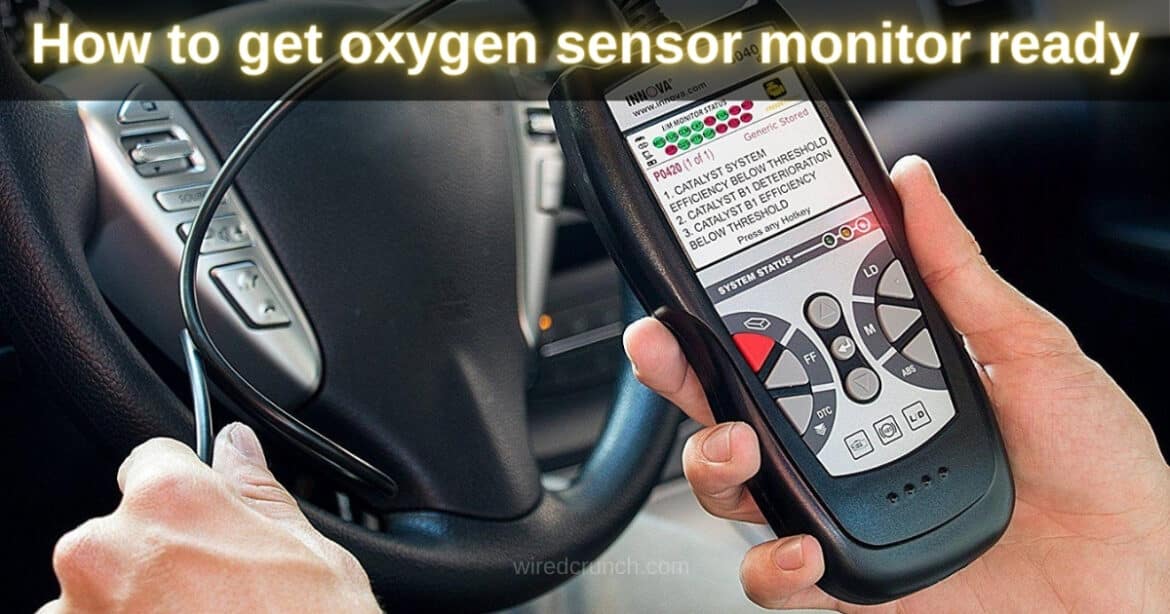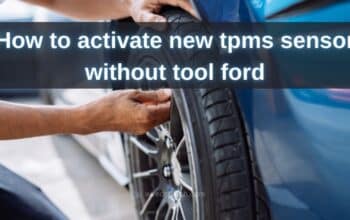Ensuring your car’s oxygen sensor monitor ready is crucial for passing emissions tests and maintaining your vehicle’s health. OBD2 readiness monitors, including the oxygen sensor monitor, are simple yet powerful self-check routines that provide insight into your car’s self-diagnostics. This tutorial will explain in detail what readiness monitors are and how they function to help you understand and manage your car’s emission control systems effectively.
Readiness monitors, also known as emissions monitors, serve a vital purpose: they self-test the car’s emission control systems to ensure everything functions correctly. As the name suggests, they observe the performance of the car’s emission-related systems and report back on their status. The importance of these monitors cannot be overstated, as they play a key role in diagnosing and maintaining the health of your vehicle’s emission systems.
In my experience, understanding how these monitors work has been precious. Cars can perform up to 11 system tests or routines, collectively known as readiness monitors. The output from these monitors indicates whether the car’s computer has completed these tests. This information is essential for passing emissions tests and ensuring your vehicle runs efficiently and safely.
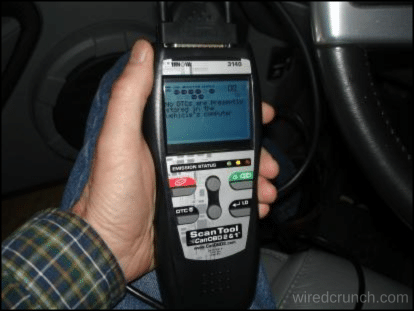
By the end of this guide, you’ll clearly understand how to get your oxygen sensor monitor ready, along with practical steps to ensure your car is prepared for any necessary emissions testing.
Table of Contents
What is Oxygen Sensor Monitor?
The oxygen sensor monitor ensures that your car’s oxygen sensors are properly calibrated and working well. These sensors help the car’s computer (PCM) keep the fuel mixture at an ideal level of 14.7:1 during normal driving. This balance is crucial for efficient combustion and low emissions.
For the oxygen sensor monitor to run, the engine and catalytic converter must be at normal operating temperatures, and the car should maintain a steady speed above 25 mph for several minutes. The check engine light must be off, indicating no serious faults, and other continuous monitors must have completed successfully.
When the oxygen sensor monitor is active, the PCM checks all oxygen sensors. The upstream sensors are tested for how quickly they respond to changes in the fuel mixture, while the downstream sensors are checked for their ability to detect lean conditions. Both sensors are monitored to ensure their signals are correct.
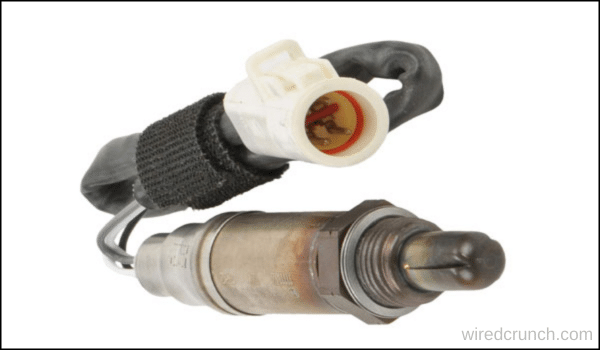
While running the monitor, the PCM performs specific tests like adjusting the fuel injectors and observing sensor responses. If any sensor faults are detected, the check engine light will come on after two driving cycles. This process helps keep your car running efficiently and ensures it meets emissions standards.
How to get oxygen sensor monitor ready
To get the oxygen sensor monitor ready, you need to follow a few specific steps. The catalytic converter monitor may require specific driving conditions before it will run. For many vehicles, this includes completing the oxygen sensor monitors first. Once that is done, you should drive at highway speeds (60 to 65 mph) for at least 10 to 15 minutes under a light load. It’s important to ensure that there are no conflicts with other monitors that have not yet run, such as the EVAP or EGR monitors.
These might need to be completed before the catalyst monitor will run. Additionally, make sure there are no fault codes that could affect the accuracy of the test. Following these steps can help you get the oxygen sensor monitor ready and ensure your vehicle’s emissions system is working properly.
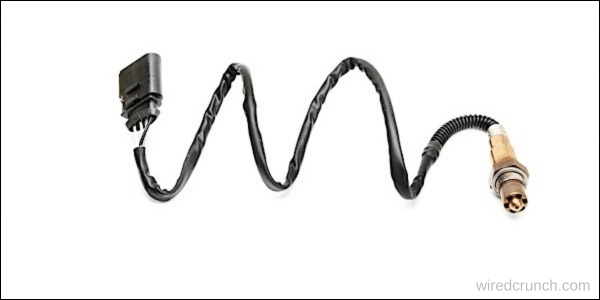
Types of Readiness Monitors
The oxygen sensor monitor is a crucial part of vehicle diagnostics. There are two types of readiness monitors: continuous and non-continuous. Continuous monitors continuously test and assess while the engine runs. In contrast, non-continuous monitors require specific conditions before they can complete a test. These conditions vary; some monitors need the vehicle to follow a specific drive cycle routine, while others require two drive cycles with cool-down and warm-up periods in between.
Each emission monitor has unique requirements. Previously, according to the OBD2 standard (SAE J1979), each monitor was categorized as one type or the other, but the latest standard edition no longer strictly categorizes them. Therefore, tools like OBD Auto Doctor no longer follow this categorization either.
Continuous or Non-Continuous Monitors
These monitors can be either type, depending on the manufacturer:
- Misfire
- Fuel System
- Comprehensive Component
Non-Continuous Monitors
Non-continuous monitors differ between spark ignition cars (gasoline engines) and compression ignition cars (diesel engines).
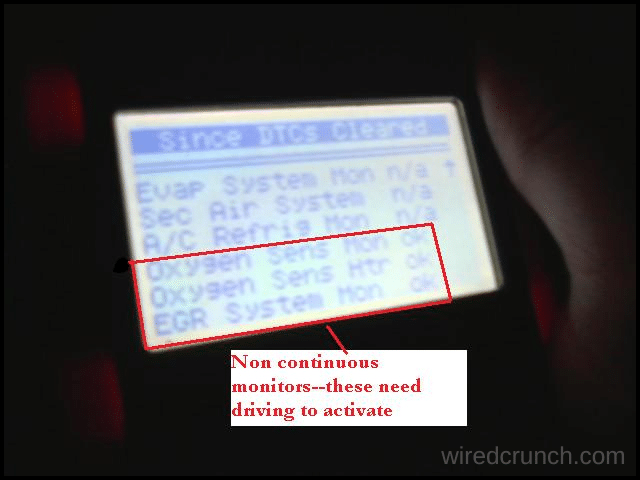
Spark Ignition Vehicles (Gas):
- Catalyst (CAT)
- Heated Catalyst
- Evaporative (EVAP) System
- Secondary Air System
- Oxygen (O2) Sensor
- Oxygen Sensor Heater
- EGR (Exhaust Gas Recirculation) and/or VVT System
Compression-Ignition Vehicles (Diesel):
- NMHC Catalyst
- NOx/SCR Aftertreatment
- Boost Pressure
- Exhaust Gas Sensor
- PM Filter
- EGR and/or VVT System
OBD readiness monitors read on Windows
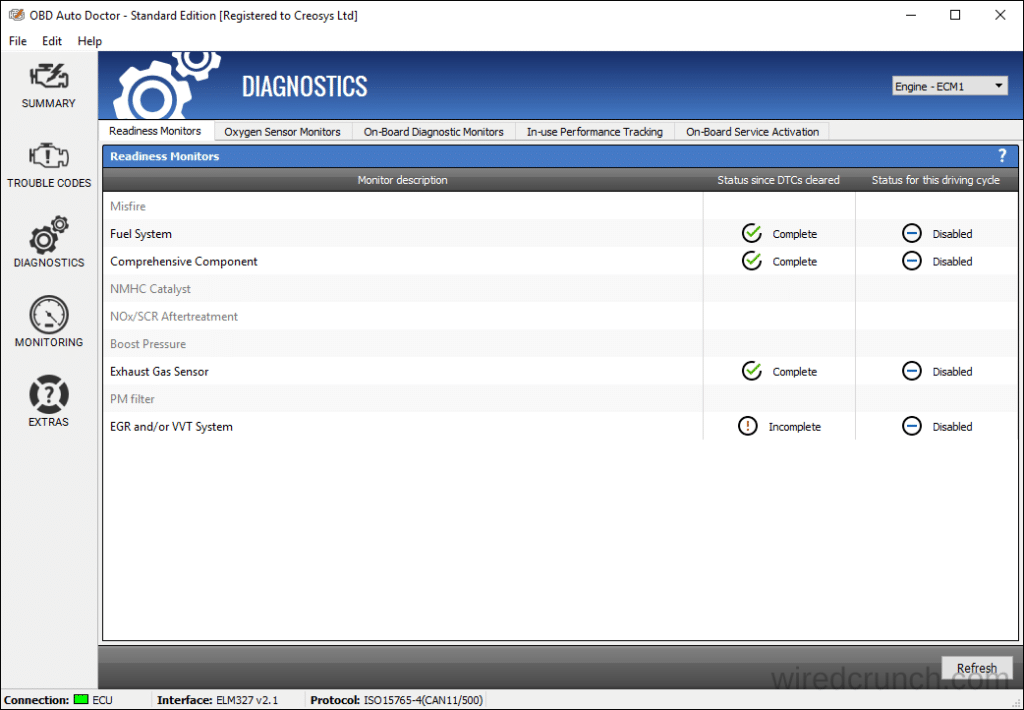
Monitoring cycles
Historically, the only available monitor status was the one reflecting the period since the diagnostic trouble codes (DTCs) were last cleared. This readiness monitor status is a requirement for all OBD2-compliant vehicles. It indicates the long-term condition following the reset of the check engine light and the clearing of the DTCs. As the OBD2 has evolved, newer vehicles can now report emission monitor status also for the current driving cycle, including the oxygen sensor monitor. These monitors start from the beginning whenever the monitoring cycle begins. Older vehicles may not support this feature. If that’s the case, OBD Auto Doctor will label it as NA, meaning Not Available.
Monitor Status
The readiness monitor test result shows the monitor status. Each readiness monitor has its output status. The completion status can include:
- Complete or ready means that the test has been completed. This indicates that the OBD-II system has checked this emissions control system and it has passed the test. OBD Auto Doctor indicates this with a green check mark.
- Incomplete or not ready means the test has not been completed. This indicates that the OBD2 system either hasn’t run this routine or it has failed. OBD Auto Doctor indicates this with a red exclamation mark.
- Disabled means that the test has been turned off for the remainder of this monitoring cycle. A monitor can be disabled when it’s difficult for the driver to operate the vehicle in a way that allows the monitor to run. For instance, this might occur if the ambient air temperature is either too low or too high.
Readiness monitors are read using the Android app. The vehicle does not support readiness monitors for this drive cycle.
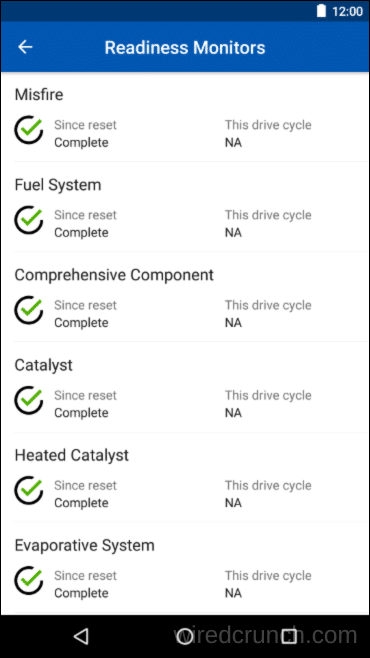
Why is a monitor marked as incomplete or “not ready”
Resetting the diagnostic trouble codes (DTCs) and the Check Engine Light also resets the monitor statuses. This usually happens during or after a vehicle repair. Statuses are also reset in case of power failure, which usually happens when the battery has been disconnected. This is why it’s generally not recommended to disconnect the battery. If you must disconnect the battery, such as for replacement purposes, continue reading for further instructions.
You will learn how to get the oxygen sensor monitor and other monitors back to complete. At the beginning of a new monitoring cycle, also known as “this drive cycle,” the status is initially marked as incomplete. It is normal for these monitors to be incomplete when starting the engine.
How to get the monitors complete or “ready”
Since the monitors are self-check routines, the best way to get them ready is to drive the car. However, simple driving might not meet all the necessary conditions. That’s why there’s something called the OBD drive cycle. But before getting into that, let’s cover the basics.
- First, ensure the MIL (Malfunction Indicator Light) is not on. Active or even pending diagnostic trouble codes may prevent a monitor from completing its run.
- Second, make sure you have enough fuel in the car. Some monitors, like the EVAP monitor, may need the fuel level to be between 35% and 85% to start the diagnostic testing.
- Third, complete the “drive cycle.” Usually, about a week of combined city and highway driving is enough to allow the monitors to reach complete status. The drive cycle is explained in more detail in the next paragraph.
OBD Drive Cycle
The OBD2 drive cycle lets your car run on-board diagnostics, allowing readiness monitors to detect potential emission system malfunctions. The correct drive cycle varies by car model and manufacturer, and details are often in the owner’s manual.
Typically, a few days of normal city and highway driving will suffice. If no specific cycle is available, use a generic one, though it may not work for all cars and monitors. Since it can be challenging to follow precisely under normal conditions, it’s best to perform the drive cycle in a restricted area.
- Begin with a cold start: coolant temperature below 50°C (122°F), and coolant and air temperatures within 11 degrees of each other. Let the car sit overnight to achieve this.
- Do not leave the ignition key in the ON position before the cold start.
- Start the engine and idle in a drive for 2.5 minutes with the A/C and rear defroster on.
- Turn off the A/C and rear defroster, then accelerate to 90 km/h (55 mph) under moderate, constant acceleration. Maintain this speed for 3 minutes.
- Slow down to 30 km/h (20 mph) without braking. If using a manual transmission, do not depress the clutch.
- Accelerate back to 90-100 km/h (55-60 mph) at 3/4 throttle. Maintain this speed for 5 minutes.
- Slow down to a stop without braking.
Oxygen Sensor Drive Cycles
Here are sample drive cycle requirements for the oxygen sensor monitor to operate:
- Ford: The monitor runs when the engine reaches normal operating temperature, the inlet air temperature is between 40 and 100 degrees F, and the vehicle cruises at a steady 40 mph for four minutes.
- GM: GM uses a two-part oxygen sensor monitor. First, idle the engine for two and a half minutes with the A/C and rear defroster on to check the sensor heater circuit. Then, turn off the A/C and defroster, accelerate at half throttle to 55 mph, and maintain a steady speed for three minutes to complete the monitor that checks the responsiveness of the O2 sensors.
- Chrysler: Idle for five minutes to reach closed-loop operation. Then drive at a steady speed above 25 mph for two minutes. Stop and idle for 30 seconds. Smoothly accelerate to 30-40 mph and repeat the last two steps five times.
- Toyota: The oxygen sensor monitor runs after idling the engine for nine minutes, followed by driving at a steady 25 mph for two minutes.
Prepare for inspection
To avoid rejection in the annual inspection, you can prepare your car for the check yourself. You should at least read the readiness monitors and make sure they are ready, especially the oxygen sensor monitor. This will significantly reduce the likelihood of being rejected. Additionally, read the diagnostic trouble codes and ensure there are none present.
All of these tasks can be accomplished using the OBD Auto Doctor diagnostic software. You can check the monitor statuses and diagnostic trouble codes even with the free version, so why not try the software right now? And remember, do not wait until the annual inspection to address issues. Taking prompt action could potentially save you considerable time, as well as expenses on future repairs and fuel.
Conclusion
Following specific manufacturer guidelines and drive cycle requirements is crucial to get the oxygen sensor monitor ready for accurate vehicle emissions testing. By ensuring the vehicle meets these conditions, drivers can effectively prepare their cars and avoid potential issues during inspections or diagnostic checks. Taking proactive steps to maintain readiness can contribute to smoother operations and better overall vehicle performance.
Frequently Asked Questions (FAQs)
Why is my oxygen sensor monitor not ready?
if the oxygen sensor and catalyst monitors are also not ready, the culprit is most likely a weak battery. if your battery is more than four years old, replace it and re-run the drive cycle. even though your car may start just fine, the pcm is hypersensitive to the slightest glitch in the battery.
How long until an O2 sensor is ready?
The O2 sensor needs to be hot to work. Depending on where it is installed in the exhaust system and whether it is self-heated or not, it can take 2–10 minutes for it to get hot enough to work.
How to get a fuel system monitor ready?
Because the monitors are self check routines, the best way to get them ready is to drive the car. Yet, monotonic driving will not most likely meet all the needed conditions.
How many readiness monitors are there?
Cars may perform up to 11 system tests; these are so called readiness monitors. The output of readiness monitors identifies whether the car’s computer has completed the required tests while the car is being driven.
What are OBD readiness monitors?
Readiness monitors are self-tests performed by the vehicle’s OBD system to verify emission control functionality.
READ MORE:
Camshaft Position Sensor Diagram Explained
I have a professional background with a Diploma in Information Communication Technology, which brings a blend of technical expertise and creative flair to my writing. Currently, I serve as a writer for Creativeoutrank LLC and contribute to their various websites.
I’m writing is a ref... Read more
